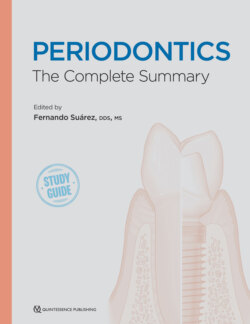Читать книгу Periodontics - Fernando Suarez - Страница 94
На сайте Литреса книга снята с продажи.
FURCATION ARROW
ОглавлениеEarly experimental studies evaluated the potential of radiographs to detect periodontal bony defects using human cadaver skulls.95–102 Prichard was the first to describe a “subtle shadow” in radiographs pointing toward the opening of the mesial furcation of maxillary first molars.99 Then, Hardekopf et al coined the term furcation arrow and defined it as a radiographic shadow associated with a proximal furcation involvement.8 Using skulls with furcation-involved molars, authors reported a significant association of Degree II and III furcation defects with the presence of furcation arrows in both mesial and distal furcation entrances when compared to noninvolved molars. For Degree I defects and noninvolved furcations, the incidence of furcation arrows was low and insignificant. Nonetheless, it was concluded that the absence of a furcation arrow does not necessarily mean an absence of a furcation involvement.8
Overall, the usefulness of the furcation arrow as a diagnostic marker is limited. When detected on radiographs, these can predict furcation involvements only in 70% of cases; yet, furcation arrows were also seen in less than 40% of sites with truly present furcation involvement. Consequently, the furcation arrow has a sensitivity of 38.7%, a specificity of 92.2%, a positive predictive value of 71.7%, and a negative predictive value of 74.6%.100
Currently, a combination of both clinical and conventional radiographic assessments remains as the gold standard approach for detecting furcation defects. Limited evidence supports the use of CBCT for periodontal disease diagnosis.101–103
